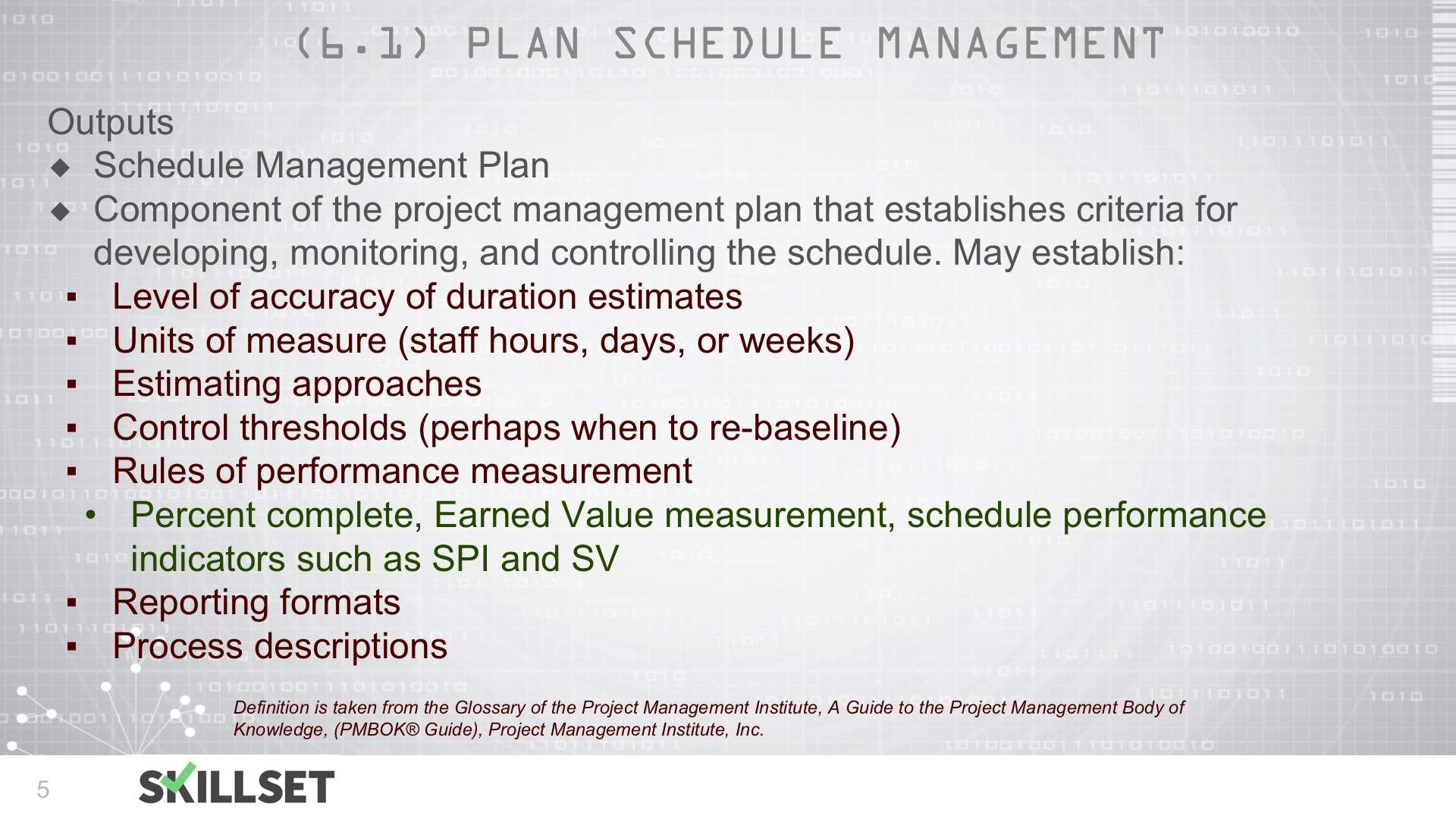Posted on by Jerome Rowley
The Define Activities process is one that takes the work packages developed in the scope management process 5.4 Create WBS and breaks them down using the same decomposition technique into the activities needed to produce each work package.
Here are the tools and techniques used in carrying out this process.
6.2.2 Define Activities: Tools and Techniques
6.2.2.1 Expert Judgment
Individuals or groups who have worked on similar past projects would be helpful in carrying out the process of working out what activities are needed to produce each work package.
6.2.2.2 Decomposition
This is the same technique used in the 5.4 Create WBS process that took the scope in the form of deliverables and divided it into smaller, more manageable parts called work packages. Work packages are things, tangible or intangible, and are therefore nouns. Activities, the effort needed to complete each work package, are verbs. When creating the activity list for each work package, any additional information about the activity (information about the other constraints associated with it such as the cost, or the resources required, etc.) are included in the activity attributes, similar to the information about the work packages included in the WBS dictionary.
Decomposition is an activity that is best done by teams rather than individuals, because one person may catch something that another person might miss if working alone. This is why decomposition is often done in meetings (see paragraph 6.2.2.4 ) below.
6.2.2.3 Rolling Wave Planning
Although planning can be done in a predictive approach, where you plan all the details of the work ahead of time, there is another, iterative approach called rolling wave planning, where the work in the near term at the beginning of the project is done in detail, but the work further down the line is planned at a higher level. It is a form of progressive elaboration of the schedule plan, but with the added feature that the work on the near term may be started before the detailed plan is completed of the work further down the line. It is like laying down the tracks for a railroad, and then having the train leave the station at one end while the tracks are still being laid down towards the other end.
6.2.2.4 Meetings
Any planning activity is best done as a team, and this is where meetings come into play as a tool for planning, especially when dealing with a technique such as decomposition.
The outputs of this process are the activity list and the list of activity attributes. These outputs are described in the next post.
Share this:
-
More
Like this:
Like
Loading…
Related
Filed under: Uncategorized |
{“appState”:{“pageLoadApiCallsStatus”:true},”articleState”:{“article”:{“headers”:{“creationTime”:”2016-03-26T13:58:28+00:00″,”modifiedTime”:”2017-04-11T14:15:56+00:00″,”timestamp”:”2022-09-14T18:18:07+00:00″},”data”:{“breadcrumbs”:[{“name”:”Academics & The Arts”,”_links”:{“self”:”https://dummies-api.dummies.com/v2/categories/33662″},”slug”:”academics-the-arts”,”categoryId”:33662},{“name”:”Study Skills & Test Prep”,”_links”:{“self”:”https://dummies-api.dummies.com/v2/categories/33772″},”slug”:”study-skills-test-prep”,”categoryId”:33772},{“name”:”PMP Certification”,”_links”:{“self”:”https://dummies-api.dummies.com/v2/categories/34326″},”slug”:”pmp-certification”,”categoryId”:34326}],”title”:”Define Activities for Planning Schedule Management on the PMP Certification Exam”,”strippedTitle”:”define activities for planning schedule management on the pmp certification exam”,”slug”:”define-activities-for-planning-schedule-management-on-the-pmp-certification-exam”,”canonicalUrl”:””,”seo”:{“metaDescription”:”After the initial planning for the schedule has been completed, you need to determine all the work that needs to be done. For PMP Certification purposes, this i”,”noIndex”:0,”noFollow”:0},”content”:”<p>After the initial planning for the schedule has been completed, you need to determine all the work that needs to be done. For PMP Certification purposes, this is referred to as Define Activities.</p>rn<p><strong>Define Activities.</strong> Identifying and documenting the specific actions to be performed to produce the project deliverables.</p>rn<p>The terms <em>activity</em> and <em>task</em> can be used interchangeably in practice, literature, and the exam.</p>rn<h2 id=”tab1″ >Define Activities: Inputs</h2>rn<p>The schedule management plan provides guidance on the level of detail you will use to record the project activities. To define activities, start with the scope baseline: in particular, the WBS. The <em>WBS</em> contains the work packages that you will decompose to determine activities. The <em>scope statement</em> — which gives a detailed narrative description of the project — contains assumptions and constraints that need to be considered.</p>rn<p>You can use organizational process assets (OPAs), such as information from previous projects or templates, to help you. The organization’s information system, including the preferred software for schedule development, is an EEF that guides your approach to recording the activities.</p>rn<h2 id=”tab2″ >Define Activities: Tools and Techniques</h2>rn<p>When you create your WBS, you decompose the work to create work packages. For creating the schedule, though, you decompose work packages to create schedule activities. For smaller projects, this may occur simultaneously. If you were redoing your backyard, you might identify the deck as a deliverable but then go right into the activities needed, such as set posts, cement posts, build frame, set planks, and build railing.</p>rn<p>It is such a small project that breaking it into two steps (identifying deliverables and the activities) doesn’t make sense. You can do them at the same time. Generally, though, on larger projects, the WBS is agreed to first, and then the decomposition into activities occurs.</p>rn<p>Activities are the actions needed to create work packages. In other words, activities are verbs. Your WBS should be noun-centric, but your activity list should be verb-centric. Look at this from the perspective of defining the activities.</p>rn<table border=”0″>rn<tbody>rn<tr>rn<th>WBS Deliverable</th> <th>Schedule Activities</th> <th>Comment</th>rn</tr>rn<tr>rn<td>1.0 Playground equipment</td>rn<td>1.1 Determine equipment needs<br /> <br /> 1.2 Conduct market research<br /> <br /> 1.3 Order equipment<br /> <br /> 1.4 Equipment delivered<br /> <br /> 1.5 Install equipment</td>rn<td>The activities are all the actions needed to complete the deliverable.<br /> <br /> The numbering scheme from the WBS is elaborated with the schedule activities.</td>rn</tr>rn</tbody>rn</table>rn<p>Using rolling wave planning is common when identifying all the activities and developing the schedule. For long projects, though, identifying all the activities that will need to take place two years in the future isn’t feasible.</p>rn<p>Therefore, identify only those detailed activities that you need to accomplish in a 90- to 120-day range and keep the information “in the future” at a higher level. With this approach, you can see how the process of planning and developing the schedule occurs throughout a project.</p>rn<p>Usually, your team members identify the activities needed to complete the work packages. They have the subject matter expertise necessary to identify the steps and work needed. In some organizations, you will be able to use a schedule from a similar project to get a head start, but you will still need to have your team members review it and modify it to meet the needs for your particular project.</p>rn<h2 id=”tab3″ >Define Activities: Outputs</h2>rn<p>The first output for this process is a list of activities. For a shorter project, you should build a comprehensive list. Comparatively, for a longer project, your list should have sufficient detail to build a realistic schedule.</p>rn<p>For complex projects, it’s appropriate to extend the description of the activities by documenting activity attributes. Activity attributes can include</p>rn<ul class=”level-one”>rn<li>rn<p class=”first-para”>Activity identifier or code (usually an extension from the WBS numbering scheme)</p>rn</li>rn<li>rn<p class=”first-para”>Activity description</p>rn</li>rn<li>rn<p class=”first-para”>Predecessor and successor activities</p>rn</li>rn<li>rn<p class=”first-para”>Logical relationships</p>rn</li>rn<li>rn<p class=”first-para”>Leads and lags</p>rn</li>rn<li>rn<p class=”first-para”>Imposed dates</p>rn</li>rn<li>rn<p class=”first-para”>Constraints</p>rn</li>rn<li>rn<p class=”first-para”>Assumptions</p>rn</li>rn<li>rn<p class=”first-para”>Required resources and skill levels</p>rn</li>rn<li>rn<p class=”first-para”>Geographic location of performance</p>rn</li>rn<li>rn<p class=”first-para”>Type of effort</p>rn</li>rn</ul>rn<p>Note that at this point in time you don’t have effort or duration information. That comes later. You can always add that information to your activity attributes as a form of progressive elaboration. A list of activity attributes might be too detailed for your project. Generally, documenting activity attributes is reserved for projects that meet the following criteria:</p>rn<ul class=”level-one”>rn<li>rn<p class=”first-para”>Large projects with a lengthy duration</p>rn</li>rn<li>rn<p class=”first-para”>Complex projects with many interdependencies and stakeholders</p>rn</li>rn<li>rn<p class=”first-para”>Projects with much uncertainty or risk</p>rn</li>rn<li>rn<p class=”first-para”>Projects that include technology that’s unproven or experimental in nature</p>rn</li>rn<li>rn<p class=”first-para”>When contractual arrangements are in place that necessitate clear and complete definition</p>rn<img src=”https://www.dummies.com/wp-content/uploads/400361.image0.jpg” width=”535″ height=”388″ alt=”An Activity Attributes form.”/> </li>rn</ul>rn<p class=”Remember”>Tailor your project to meet your needs. If you don’t need to record activity attributes, don’t. If you need only specific information, create a form that suits your needs.</p>rn<p>A final output of this process is a milestone list. This records all the milestones and communicates if they are mandatory (as required by a contract) or optional.</p>rn<p><strong>Milestone</strong><strong>.</strong> A significant point or event in the project.</p>”,”description”:”<p>After the initial planning for the schedule has been completed, you need to determine all the work that needs to be done. For PMP Certification purposes, this is referred to as Define Activities.</p>rn<p><strong>Define Activities.</strong> Identifying and documenting the specific actions to be performed to produce the project deliverables.</p>rn<p>The terms <em>activity</em> and <em>task</em> can be used interchangeably in practice, literature, and the exam.</p>rn<h2 id=”tab1″ >Define Activities: Inputs</h2>rn<p>The schedule management plan provides guidance on the level of detail you will use to record the project activities. To define activities, start with the scope baseline: in particular, the WBS. The <em>WBS</em> contains the work packages that you will decompose to determine activities. The <em>scope statement</em> — which gives a detailed narrative description of the project — contains assumptions and constraints that need to be considered.</p>rn<p>You can use organizational process assets (OPAs), such as information from previous projects or templates, to help you. The organization’s information system, including the preferred software for schedule development, is an EEF that guides your approach to recording the activities.</p>rn<h2 id=”tab2″ >Define Activities: Tools and Techniques</h2>rn<p>When you create your WBS, you decompose the work to create work packages. For creating the schedule, though, you decompose work packages to create schedule activities. For smaller projects, this may occur simultaneously. If you were redoing your backyard, you might identify the deck as a deliverable but then go right into the activities needed, such as set posts, cement posts, build frame, set planks, and build railing.</p>rn<p>It is such a small project that breaking it into two steps (identifying deliverables and the activities) doesn’t make sense. You can do them at the same time. Generally, though, on larger projects, the WBS is agreed to first, and then the decomposition into activities occurs.</p>rn<p>Activities are the actions needed to create work packages. In other words, activities are verbs. Your WBS should be noun-centric, but your activity list should be verb-centric. Look at this from the perspective of defining the activities.</p>rn<table border=”0″>rn<tbody>rn<tr>rn<th>WBS Deliverable</th> <th>Schedule Activities</th> <th>Comment</th>rn</tr>rn<tr>rn<td>1.0 Playground equipment</td>rn<td>1.1 Determine equipment needs<br /> <br /> 1.2 Conduct market research<br /> <br /> 1.3 Order equipment<br /> <br /> 1.4 Equipment delivered<br /> <br /> 1.5 Install equipment</td>rn<td>The activities are all the actions needed to complete the deliverable.<br /> <br /> The numbering scheme from the WBS is elaborated with the schedule activities.</td>rn</tr>rn</tbody>rn</table>rn<p>Using rolling wave planning is common when identifying all the activities and developing the schedule. For long projects, though, identifying all the activities that will need to take place two years in the future isn’t feasible.</p>rn<p>Therefore, identify only those detailed activities that you need to accomplish in a 90- to 120-day range and keep the information “in the future” at a higher level. With this approach, you can see how the process of planning and developing the schedule occurs throughout a project.</p>rn<p>Usually, your team members identify the activities needed to complete the work packages. They have the subject matter expertise necessary to identify the steps and work needed. In some organizations, you will be able to use a schedule from a similar project to get a head start, but you will still need to have your team members review it and modify it to meet the needs for your particular project.</p>rn<h2 id=”tab3″ >Define Activities: Outputs</h2>rn<p>The first output for this process is a list of activities. For a shorter project, you should build a comprehensive list. Comparatively, for a longer project, your list should have sufficient detail to build a realistic schedule.</p>rn<p>For complex projects, it’s appropriate to extend the description of the activities by documenting activity attributes. Activity attributes can include</p>rn<ul class=”level-one”>rn<li>rn<p class=”first-para”>Activity identifier or code (usually an extension from the WBS numbering scheme)</p>rn</li>rn<li>rn<p class=”first-para”>Activity description</p>rn</li>rn<li>rn<p class=”first-para”>Predecessor and successor activities</p>rn</li>rn<li>rn<p class=”first-para”>Logical relationships</p>rn</li>rn<li>rn<p class=”first-para”>Leads and lags</p>rn</li>rn<li>rn<p class=”first-para”>Imposed dates</p>rn</li>rn<li>rn<p class=”first-para”>Constraints</p>rn</li>rn<li>rn<p class=”first-para”>Assumptions</p>rn</li>rn<li>rn<p class=”first-para”>Required resources and skill levels</p>rn</li>rn<li>rn<p class=”first-para”>Geographic location of performance</p>rn</li>rn<li>rn<p class=”first-para”>Type of effort</p>rn</li>rn</ul>rn<p>Note that at this point in time you don’t have effort or duration information. That comes later. You can always add that information to your activity attributes as a form of progressive elaboration. A list of activity attributes might be too detailed for your project. Generally, documenting activity attributes is reserved for projects that meet the following criteria:</p>rn<ul class=”level-one”>rn<li>rn<p class=”first-para”>Large projects with a lengthy duration</p>rn</li>rn<li>rn<p class=”first-para”>Complex projects with many interdependencies and stakeholders</p>rn</li>rn<li>rn<p class=”first-para”>Projects with much uncertainty or risk</p>rn</li>rn<li>rn<p class=”first-para”>Projects that include technology that’s unproven or experimental in nature</p>rn</li>rn<li>rn<p class=”first-para”>When contractual arrangements are in place that necessitate clear and complete definition</p>rn<img src=”https://www.dummies.com/wp-content/uploads/400361.image0.jpg” width=”535″ height=”388″ alt=”An Activity Attributes form.”/> </li>rn</ul>rn<p class=”Remember”>Tailor your project to meet your needs. If you don’t need to record activity attributes, don’t. If you need only specific information, create a form that suits your needs.</p>rn<p>A final output of this process is a milestone list. This records all the milestones and communicates if they are mandatory (as required by a contract) or optional.</p>rn<p><strong>Milestone</strong><strong>.</strong> A significant point or event in the project.</p>”,”blurb”:””,”authors”:[{“authorId”:9527,”name”:”Cynthia Snyder Stackpole”,”slug”:”cynthia-snyder-stackpole”,”description”:””,”hasArticle”:false,”_links”:{“self”:”https://dummies-api.dummies.com/v2/authors/9527″}}],”primaryCategoryTaxonomy”:{“categoryId”:34326,”title”:”PMP Certification”,”slug”:”pmp-certification”,”_links”:{“self”:”https://dummies-api.dummies.com/v2/categories/34326″}},”secondaryCategoryTaxonomy”:{“categoryId”:0,”title”:null,”slug”:null,”_links”:null},”tertiaryCategoryTaxonomy”:{“categoryId”:0,”title”:null,”slug”:null,”_links”:null},”trendingArticles”:null,”inThisArticle”:[{“label”:”Define Activities: Inputs”,”target”:”#tab1″},{“label”:”Define Activities: Tools and Techniques”,”target”:”#tab2″},{“label”:”Define Activities: Outputs”,”target”:”#tab3″}],”relatedArticles”:{“fromBook”:[],”fromCategory”:[{“articleId”:163067,”title”:”Understand Scheduling Relationships for the PMP Certification Exam”,”slug”:”understand-scheduling-relationships-for-the-pmp-certification-exam”,”categoryList”:[“academics-the-arts”,”study-skills-test-prep”,”pmp-certification”],”_links”:{“self”:”https://dummies-api.dummies.com/v2/articles/163067″}},{“articleId”:163065,”title”:”PMP Certification: 6 Strategies for Conflict Resolution”,”slug”:”pmp-certification-6-strategies-for-conflict-resolution”,”categoryList”:[“academics-the-arts”,”study-skills-test-prep”,”pmp-certification”],”_links”:{“self”:”https://dummies-api.dummies.com/v2/articles/163065″}},{“articleId”:163066,”title”:”PMP Certification: 4 Estimating Techniques for Project Managers”,”slug”:”pmp-certification-4-estimating-techniques-for-project-managers”,”categoryList”:[“academics-the-arts”,”study-skills-test-prep”,”pmp-certification”],”_links”:{“self”:”https://dummies-api.dummies.com/v2/articles/163066″}},{“articleId”:163063,”title”:”PMP Earned Value: Variances and Indexes”,”slug”:”pmp-earned-value-variances-and-indexes”,”categoryList”:[“academics-the-arts”,”study-skills-test-prep”,”pmp-certification”],”_links”:{“self”:”https://dummies-api.dummies.com/v2/articles/163063″}},{“articleId”:163064,”title”:”PMP Exam: Statistics for Normal and Cumulative Distributions”,”slug”:”pmp-exam-statistics-for-normal-and-cumulative-distributions”,”categoryList”:[“academics-the-arts”,”study-skills-test-prep”,”pmp-certification”],”_links”:{“self”:”https://dummies-api.dummies.com/v2/articles/163064″}}]},”hasRelatedBookFromSearch”:true,”relatedBook”:{“bookId”:281603,”slug”:”study-skills-for-dummies”,”isbn”:”9780470740477″,”categoryList”:[“academics-the-arts”,”study-skills-test-prep”,”general-study-skills-test-prep”],”amazon”:{“default”:”https://www.amazon.com/gp/product/0470740477/ref=as_li_tl?ie=UTF8&tag=wiley01-20″,”ca”:”https://www.amazon.ca/gp/product/0470740477/ref=as_li_tl?ie=UTF8&tag=wiley01-20″,”indigo_ca”:”http://www.tkqlhce.com/click-9208661-13710633?url=https://www.chapters.indigo.ca/en-ca/books/product/0470740477-item.html&cjsku=978111945484″,”gb”:”https://www.amazon.co.uk/gp/product/0470740477/ref=as_li_tl?ie=UTF8&tag=wiley01-20″,”de”:”https://www.amazon.de/gp/product/0470740477/ref=as_li_tl?ie=UTF8&tag=wiley01-20″},”image”:{“src”:”https://www.dummies.com/wp-content/uploads/study-skills-for-dummies-cover-9780470740477-203×255.jpg”,”width”:203,”height”:255},”title”:”Study Skills For Dummies”,”testBankPinActivationLink”:””,”bookOutOfPrint”:true,”authorsInfo”:”n <p><b data-author-id=”34430″>Doreen du Boulay</b> has been a learning advisor and student tutor in study skills support at Sussex University. She has also worked as a teacher, essay examiner, and MA dissertation marker.</p>”,”authors”:[{“authorId”:34430,”name”:”Doreen du Boulay”,”slug”:”doreen-du-boulay”,”description”:”Doreen du Boulay has been a learning advisor and student tutor in study skills support at Sussex University. She has also worked as a teacher, essay examiner, and MA dissertation marker. “,”hasArticle”:false,”_links”:{“self”:”https://dummies-api.dummies.com/v2/authors/34430″}}],”_links”:{“self”:”https://dummies-api.dummies.com/v2/books/281603″}},”collections”:[],”articleAds”:{“footerAd”:”<div class=”du-ad-region row” id=”article_page_adhesion_ad”><div class=”du-ad-unit col-md-12″ data-slot-id=”article_page_adhesion_ad” data-refreshed=”false” rn data-target = “[{"key":"cat","values":["academics-the-arts","study-skills-test-prep","pmp-certification"]},{"key":"isbn","values":[null]}]” id=”du-slot-63221adff2719″></div></div>”,”rightAd”:”<div class=”du-ad-region row” id=”article_page_right_ad”><div class=”du-ad-unit col-md-12″ data-slot-id=”article_page_right_ad” data-refreshed=”false” rn data-target = “[{"key":"cat","values":["academics-the-arts","study-skills-test-prep","pmp-certification"]},{"key":"isbn","values":[null]}]” id=”du-slot-63221adff2c4a”></div></div>”},”articleType”:{“articleType”:”Articles”,”articleList”:null,”content”:null,”videoInfo”:{“videoId”:null,”name”:null,”accountId”:null,”playerId”:null,”thumbnailUrl”:null,”description”:null,”uploadDate”:null}},”sponsorship”:{“sponsorshipPage”:false,”backgroundImage”:{“src”:null,”width”:0,”height”:0},”brandingLine”:””,”brandingLink”:””,”brandingLogo”:{“src”:null,”width”:0,”height”:0},”sponsorAd”:””,”sponsorEbookTitle”:””,”sponsorEbookLink”:””,”sponsorEbookImage”:{“src”:null,”width”:0,”height”:0}},”primaryLearningPath”:”Advance”,”lifeExpectancy”:null,”lifeExpectancySetFrom”:null,”dummiesForKids”:”no”,”sponsoredContent”:”no”,”adInfo”:””,”adPairKey”:[]},”status”:”publish”,”visibility”:”public”,”articleId”:160585},”articleLoadedStatus”:”success”},”listState”:{“list”:{},”objectTitle”:””,”status”:”initial”,”pageType”:null,”objectId”:null,”page”:1,”sortField”:”time”,”sortOrder”:1,”categoriesIds”:[],”articleTypes”:[],”filterData”:{},”filterDataLoadedStatus”:”initial”,”pageSize”:10},”adsState”:{“pageScripts”:{“headers”:{“timestamp”:”2022-11-21T10:50:01+00:00″},”adsId”:0,”data”:{“scripts”:[{“pages”:[“all”],”location”:”header”,”script”:”<!–Optimizely Script–>rn<script src=”https://cdn.optimizely.com/js/10563184655.js”></script>”,”enabled”:false},{“pages”:[“all”],”location”:”header”,”script”:”<!– comScore Tag –>rn<script>var _comscore = _comscore || [];_comscore.push({ c1: “2”, c2: “15097263” });(function() {var s = document.createElement(“script”), el = document.getElementsByTagName(“script”)[0]; s.async = true;s.src = (document.location.protocol == “https:” ? “https://sb” : “http://b”) + “.scorecardresearch.com/beacon.js”;el.parentNode.insertBefore(s, el);})();</script><noscript><img src=”https://sb.scorecardresearch.com/p?c1=2&c2=15097263&cv=2.0&cj=1″ /></noscript>rn<!– / comScore Tag –>”,”enabled”:true},{“pages”:[“all”],”location”:”footer”,”script”:”<!–BEGIN QUALTRICS WEBSITE FEEDBACK SNIPPET–>rn<script type=’text/javascript’>rn(function(){var g=function(e,h,f,g){rnthis.get=function(a){for(var a=a+”=”,c=document.cookie.split(“;”),b=0,e=c.length;b<e;b++){for(var d=c[b];” “==d.charAt(0);)d=d.substring(1,d.length);if(0==d.indexOf(a))return d.substring(a.length,d.length)}return null};rnthis.set=function(a,c){var b=””,b=new Date;b.setTime(b.getTime()+6048E5);b=”; expires=”+b.toGMTString();document.cookie=a+”=”+c+b+”; path=/; “};rnthis.check=function(){var a=this.get(f);if(a)a=a.split(“:”);else if(100!=e)”v”==h&&(e=Math.random()>=e/100?0:100),a=[h,e,0],this.set(f,a.join(“:”));else return!0;var c=a[1];if(100==c)return!0;switch(a[0]){case “v”:return!1;case “r”:return c=a[2]%Math.floor(100/c),a[2]++,this.set(f,a.join(“:”)),!c}return!0};rnthis.go=function(){if(this.check()){var a=document.createElement(“script”);a.type=”text/javascript”;a.src=g;document.body&&document.body.appendChild(a)}};rnthis.start=function(){var t=this;”complete”!==document.readyState?window.addEventListener?window.addEventListener(“load”,function(){t.go()},!1):window.attachEvent&&window.attachEvent(“onload”,function(){t.go()}):t.go()};};rntry{(new g(100,”r”,”QSI_S_ZN_5o5yqpvMVjgDOuN”,”https://zn5o5yqpvmvjgdoun-wiley.siteintercept.qualtrics.com/SIE/?Q_ZID=ZN_5o5yqpvMVjgDOuN”)).start()}catch(i){}})();rn</script><div id=’ZN_5o5yqpvMVjgDOuN’><!–DO NOT REMOVE-CONTENTS PLACED HERE–></div>rn<!–END WEBSITE FEEDBACK SNIPPET–>”,”enabled”:false},{“pages”:[“all”],”location”:”header”,”script”:”<!– Hotjar Tracking Code for http://www.dummies.com –>rn<script>rn (function(h,o,t,j,a,r){rn h.hj=h.hj||function(){(h.hj.q=h.hj.q||[]).push(arguments)};rn h._hjSettings={hjid:257151,hjsv:6};rn a=o.getElementsByTagName(‘head’)[0];rn r=o.createElement(‘script’);r.async=1;rn r.src=t+h._hjSettings.hjid+j+h._hjSettings.hjsv;rn a.appendChild(r);rn })(window,document,’https://static.hotjar.com/c/hotjar-‘,’.js?sv=’);rn</script>”,”enabled”:false},{“pages”:[“article”],”location”:”header”,”script”:”<!– //Connect Container: dummies –> <script src=”//get.s-onetag.com/bffe21a1-6bb8-4928-9449-7beadb468dae/tag.min.js” async defer></script>”,”enabled”:true},{“pages”:[“homepage”],”location”:”header”,”script”:”<meta name=”facebook-domain-verification” content=”irk8y0irxf718trg3uwwuexg6xpva0″ />”,”enabled”:true},{“pages”:[“homepage”,”article”,”category”,”search”],”location”:”footer”,”script”:”<!– Facebook Pixel Code –>rn<noscript>rn<img height=”1″ width=”1″ src=”https://www.facebook.com/tr?id=256338321977984&ev=PageView&noscript=1″/>rn</noscript>rn<!– End Facebook Pixel Code –>”,”enabled”:true}]}},”pageScriptsLoadedStatus”:”success”},”navigationState”:{“navigationCollections”:[{“collectionId”:287568,”title”:”BYOB (Be Your Own Boss)”,”hasSubCategories”:false,”url”:”/collection/for-the-entry-level-entrepreneur-287568″},{“collectionId”:293237,”title”:”Be a Rad Dad”,”hasSubCategories”:false,”url”:”/collection/be-the-best-dad-293237″},{“collectionId”:294090,”title”:”Contemplating the Cosmos”,”hasSubCategories”:false,”url”:”/collection/theres-something-about-space-294090″},{“collectionId”:287563,”title”:”For Those Seeking Peace of Mind”,”hasSubCategories”:false,”url”:”/collection/for-those-seeking-peace-of-mind-287563″},{“collectionId”:287570,”title”:”For the Aspiring Aficionado”,”hasSubCategories”:false,”url”:”/collection/for-the-bougielicious-287570″},{“collectionId”:291903,”title”:”For the Budding Cannabis Enthusiast”,”hasSubCategories”:false,”url”:”/collection/for-the-budding-cannabis-enthusiast-291903″},{“collectionId”:291934,”title”:”For the Exam-Season Crammer”,”hasSubCategories”:false,”url”:”/collection/for-the-exam-season-crammer-291934″},{“collectionId”:287569,”title”:”For the Hopeless Romantic”,”hasSubCategories”:false,”url”:”/collection/for-the-hopeless-romantic-287569″},{“collectionId”:287567,”title”:”For the Unabashed Hippie”,”hasSubCategories”:false,”url”:”/collection/for-the-unabashed-hippie-287567″},{“collectionId”:295430,”title”:”Have a Beautiful (and Tasty) Thanksgiving”,”hasSubCategories”:false,”url”:”/collection/have-a-wonderful-thanksgiving-295430″}],”navigationCollectionsLoadedStatus”:”success”,”navigationCategories”:{“books”:{“0”:{“data”:[{“categoryId”:33512,”title”:”Technology”,”hasSubCategories”:true,”url”:”/category/books/technology-33512″},{“categoryId”:33662,”title”:”Academics & The Arts”,”hasSubCategories”:true,”url”:”/category/books/academics-the-arts-33662″},{“categoryId”:33809,”title”:”Home, Auto, & Hobbies”,”hasSubCategories”:true,”url”:”/category/books/home-auto-hobbies-33809″},{“categoryId”:34038,”title”:”Body, Mind, & Spirit”,”hasSubCategories”:true,”url”:”/category/books/body-mind-spirit-34038″},{“categoryId”:34224,”title”:”Business, Careers, & Money”,”hasSubCategories”:true,”url”:”/category/books/business-careers-money-34224″}],”breadcrumbs”:[],”categoryTitle”:”Level 0 Category”,”mainCategoryUrl”:”/category/books/level-0-category-0″}},”articles”:{“0”:{“data”:[{“categoryId”:33512,”title”:”Technology”,”hasSubCategories”:true,”url”:”/category/articles/technology-33512″},{“categoryId”:33662,”title”:”Academics & The Arts”,”hasSubCategories”:true,”url”:”/category/articles/academics-the-arts-33662″},{“categoryId”:33809,”title”:”Home, Auto, & Hobbies”,”hasSubCategories”:true,”url”:”/category/articles/home-auto-hobbies-33809″},{“categoryId”:34038,”title”:”Body, Mind, & Spirit”,”hasSubCategories”:true,”url”:”/category/articles/body-mind-spirit-34038″},{“categoryId”:34224,”title”:”Business, Careers, & Money”,”hasSubCategories”:true,”url”:”/category/articles/business-careers-money-34224″}],”breadcrumbs”:[],”categoryTitle”:”Level 0 Category”,”mainCategoryUrl”:”/category/articles/level-0-category-0″}}},”navigationCategoriesLoadedStatus”:”success”},”searchState”:{“searchList”:[],”searchStatus”:”initial”,”relatedArticlesList”:[],”relatedArticlesStatus”:”initial”},”routeState”:{“name”:”Article3″,”path”:”/article/academics-the-arts/study-skills-test-prep/pmp-certification/define-activities-for-planning-schedule-management-on-the-pmp-certification-exam-160585/”,”hash”:””,”query”:{},”params”:{“category1″:”academics-the-arts”,”category2″:”study-skills-test-prep”,”category3″:”pmp-certification”,”article”:”define-activities-for-planning-schedule-management-on-the-pmp-certification-exam-160585″},”fullPath”:”/article/academics-the-arts/study-skills-test-prep/pmp-certification/define-activities-for-planning-schedule-management-on-the-pmp-certification-exam-160585/”,”meta”:{“routeType”:”article”,”breadcrumbInfo”:{“suffix”:”Articles”,”baseRoute”:”/category/articles”},”prerenderWithAsyncData”:true},”from”:{“name”:null,”path”:”/”,”hash”:””,”query”:{},”params”:{},”fullPath”:”/”,”meta”:{}}},”dropsState”:{“submitEmailResponse”:false,”status”:”initial”},”sfmcState”:{“status”:”initial”},”profileState”:{“auth”:{},”userOptions”:{},”status”:”success”}}




